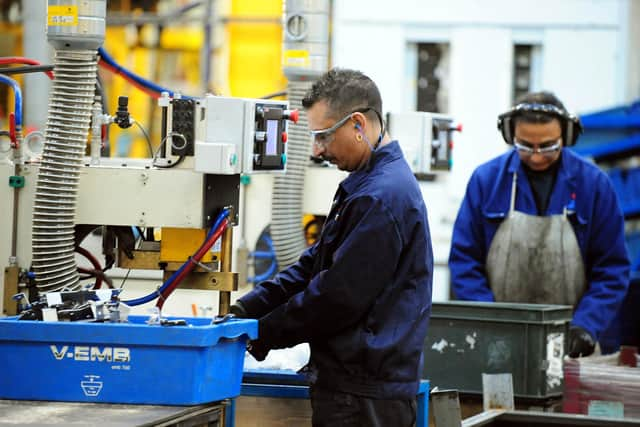UK economy: Manufacturing output falls but interest rates set to rise further this week
Companies said they were receiving reduced levels of new work and demand was weakening, all while they grappled with supply chain problems.
That resulted in the closely watched S&P Global/Cips UK manufacturing purchasing Managers’ index (PMI) slipping to 52.1 last month, down from a reading of 52.8 in June.
Advertisement
Hide AdAdvertisement
Hide AdThe index was still in growth territory - anything above 50 denotes expansion - but only because of faster jobs growth and rising purchase stocks.
On the output side it was the first time since May 2020 that the sector had contracted, mainly due to consumer and intermediate goods - products that go into making consumer goods, which are the final items sold to regular customers.
Businesses noted that the cost-of-living crisis was contributing to the drop in new orders. They also blamed domestic demand, client uncertainty, warmer-than-usual weather and reduced exports.
Demand from overseas fell for the sixth month in a row, in part due to Brexit fallout.
Rob Dobson, director at S&P Global Market Intelligence, said: “The UK manufacturing sector shifted into reverse gear at the start of the third quarter. Output contracted for the first time since May 2020, as new order intakes suffered the first back-to-back monthly decreases for two years.


“Rising market uncertainty, the cost-of-living crisis, war in Ukraine, ongoing supply issues and inflationary pressures are all hitting demand for goods at the same time, while lingering post-Brexit issues and the darkening global economic backdrop are hampering exports.”
Martin Beck, chief economic advisor to the EY Item Club, said: “The one bright spot was evidence that inflationary pressures are starting to ease. Manufacturers’ input costs rose at the slowest pace since January 2021, following a broad-based fall in commodity prices.
“The combination of weaker input cost pressures and softer demand meant that companies increased their prices at the slowest pace since last May.
Advertisement
Hide AdAdvertisement
Hide Ad“The MPC [Bank of England’s monetary policy committee) should be heartened by the cooling in inflationary pressures. But it’s unlikely to have any impact on their thinking for this week’s meeting, where a rate rise of at least 25 basis points [0.25 per cent] is certain and an increase of 50 points [0.5 per cent] is a live possibility.”
Dobson said more pressures could arise as the central bank continues to hike interest rates to combat inflation.
However, there are signs in the data that costs are no longer increasing as fast as they had been, which could provide a welcome break for companies.
Duncan Brock, group director at the Chartered Institute of Procurement & Supply (Cips), said: “Output from the consumer goods sector went into contraction along with new orders, and the signs show this trend will continue towards the autumn months.
“A reduction in the level of new orders from domestic customers clearly showed that the pressure of cost-of-living rises for basics such as fuel and energy made consumers think twice about non-essential purchases.”
Comments
Want to join the conversation? Please or to comment on this article.